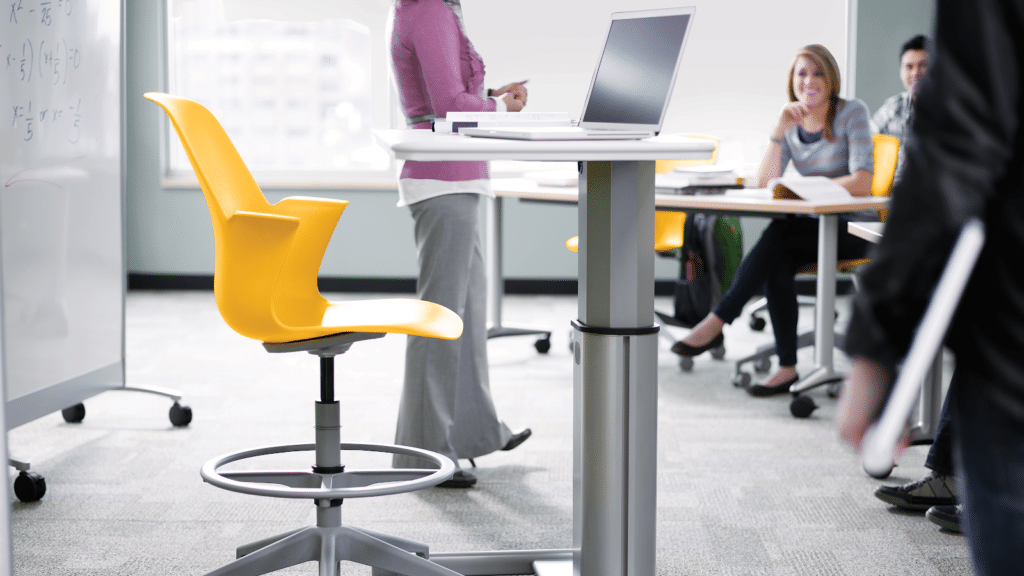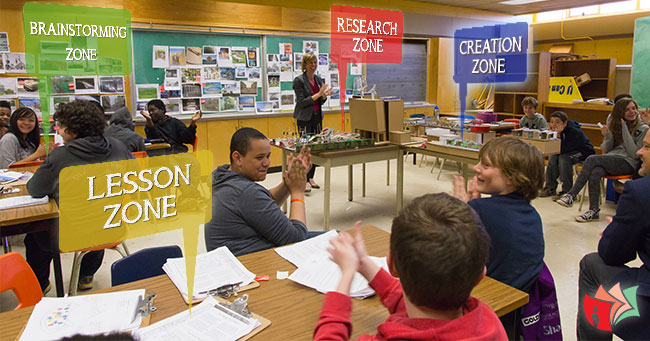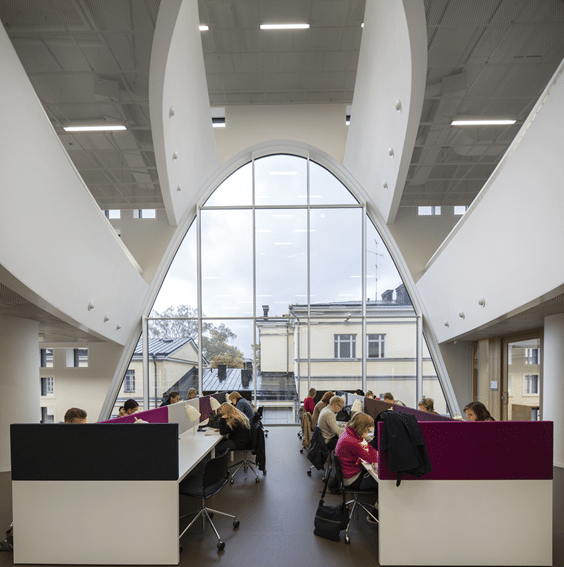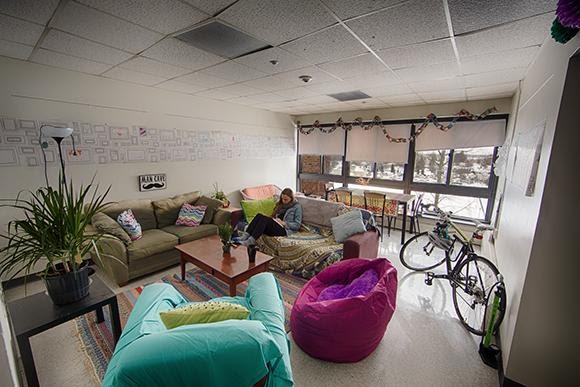It is well known that the environment shapes the personality of a human being.
As such, it makes sense that schools, which is where students begin to learn and to engage with their environment and the people around them, is a vital environment.
The first introduction to society is within the family, as it is the first social environment.
The design of classrooms is leaving the traditional, teacher-focused classroom behind and heading towards an open, flexible layout with furniture that supports technology-enhanced learning and student group projects.
The ideas that follow, support a sustainable perspective, as necessary and vital to respect the environment and to preserve it.
Table of Contents
Classroom Innovations – Integration of Technological Equipment within the Lessons
Technology nowadays is playing a splendid role in everyone’s life. It is embedded in society and schools are using it to help their students with their studies, research and speeding up the learning process.
The 21st-century classrooms are designed with two key concepts; fast access to technology and a student-centred architecture.
In order to get the full benefits given by technology, classrooms have started to be equipped with an LCD projector, a document camera, an additional wireless router and a high-tech whiteboard.

Almost all the schools around the world are embracing the idea of IT integration within the school’s environment.

Infographic from hooked on innovations
Nowadays, on average, 60% of schools provide the tools for students to study, some even allow them to use their own devices. Students become more active and responsible in their own learning process.
Technology in schools can bring many advantages, but also disadvantages.
It is such an important thing as technology can help the students connect with each other in a variety of situations, for example, messaging platforms can be used by individuals within a group project, especially when not in the same location. Technology platforms can become a way to stay informed and ensure everyone feels able to participate equally in school activities
Through integrating technology in the classroom, students can broaden their knowledge, gain differing insights and be more involved and engaged in debates.
When talking about IT integration, it helps to bring fun while studying! Animated games with popular characters can explain everything from the solar system to the texts of Aristotle.
The disadvantages are manifold, including someone who struggles with… distraction.
This is harmful, but perhaps not as serious as a more evident trend, the temptation for students to use their devices to cheat during exams. This problem has been overcome by the introduction of thorough controls, digital citizenship contracts and IT-specific training for teachers.
Example of Technology Integration in the Classroom
Classroom Layout Design – Decentralizing the Classroom.
Students should feel confident and comfortable in class.
Creating a student-focused environment is one of the main priorities for learning institutions.
A change that is relevant is that the teacher’s desk has been replaced by a podium that can be moved around the room.
The decentralization of a classroom has a focused goal, to create a polycentric layout in order to capture and maintain the attention of all students.

Unlike the traditional methods of education, where the student had to follow the teacher, today students are becoming more responsible for their own learning and the teachers are seen as guides, to help facilitate when it is needed.
Example of Decentralized Classroom – Students LOVE it!
Related Article: “Modular Architecture – It’s the Future”
Architecture Design in Classrooms – Flexible Desk Furniture.
Flexible classroom furniture transforms the way students learn.
Rearranging a learning space several times during the course of the day draws students’ attention and allows for a variety of tasks.
They’re going to be better able to absorb and process information based on a higher level of engagement with the work they’re doing.
These environments encourage innovation and will help the students to actively develop their interests by learning in different ways.
Most jobs in the modern world require some degree of collaboration and so the ability to work cooperatively to achieve a goal or complete a task is important for everyone.

Environmental and economical benefits include saving raw materials and money.
This is because schools can use the same flexible classroom furniture in many ways, rather than having to purchase new items for specific purposes. In this way, sustainability is achieved and maintained across the school.
North Arkansas High School classroom is a typical example of using flexible desk furniture.
It has been revolutionary and other schools have followed in their footsteps to great success.
Examples of Classroom Arrangement Styles
Classroom Design Innovations – Collaborative and Sustainable Workspaces
No matter the level of studies, student group projects are an important component of today’s learning programs. Through the use of multi-functional tables, it is easy to arrange the environment to suit the task.
Supervision is necessary, in order to see if the set activities are bringing the expected results. But, teachers are changing the way they deliver information and also the purpose of the classroom itself.
The approach towards studying is more collaborative, teachers are experimenting with different ways of teaching, such as discussion through the debates, learning by listening, learning by doing.
The contemporary classroom is closer to the Socratic idea of innovation and it has brought great results

The Community College Survey of Student Engagement (CCSSE) at The University of Austin in Texas evaluated innovative solutions based on collaborative working spaces that are able to reinforce the co-working of students; it is important to outline that in Community College just half of the students move to 2nd year.
Many of the students leave due to problems related to the active and collaborative learning that occurs with others, improve this, improve graduation rates.
An Example of Students Working in a Collaborative Workspace to Learn
Example of Innovations in the Classroom: Sustainable movable room dividers
Safety and flexibility are pillars for the classrooms of the future.
Architects think that classrooms are best with stable, movable room dividers that can help to organize an educational space in new ways.
Incorporating erasable chalkboard or whiteboard surfaces onto the partitioning systems enables students to depict a graphic vision of the group work and is helpful when discussing and exchanging opinions with each other.
This would also help the students in achieving a better group work experience.
The advantage can also be that these can create temporary classrooms because they are easy to assemble and to carry.

This is an example of a room divider, it is very functional as students can use it during the curricular courses and also in group work. It saves space and it reduces noise.
Dividers Eliminating Distractions in the Classroom:
Architects Redesigning Classrooms – Comfortable Chairs
Reading at a desk can be uncomfortable for long periods of time. Why have the offices of the future placed an emphasis on comfort?
Many classrooms now offer comfortable chairs that allow students to study for longer hours.
This should be seen as an opportunity to improve the design of chairs and to take into consideration better ideas to achieve a better experience

Comfortable chairs help the user avoid physical and health problems in the near future. Once it is possible to avoid these problems, fewer adults will have to face them in the future.
Classroom Innovations: Presentation Areas
Teachers need to be able to provide formative assessment. In order to help students improve their educational outcomes, instructors need feedback loops.
Presentation areas are spaces where the students can talk about the presentation within their groups and improve overall performances both as an individual and as a group.
Reimaging an environment that is comfortable for both teachers and students includes providing an area with a space for the laptops, ergonomic chairs, and large tables to be occupied by the teachers.
These appropriately equipped spaces allow for organized learning demonstrations that encourage relaxation and confidence in students.
A good example of presentation areas is given by the library at Pershing County High School.

Pershing County High School, Nevada.
Clever Classroom Design by Architects
Innovative design for the classroom – Quiet Areas
As the rooms in a school are mainly open spaces with many people, it can be hard to concentrate on tasks such as reading. Quiet areas in a learning environment are necessary for both students and teachers.
A quiet area can be used by students that prefer to work alone ,(not all students’ personalities are the same) or if they are looking for a place to write and to concentrate.

A school in New York, the Queen North Primary School, decided to create break areas – quiet corners for self-regulation and social-emotional learning.
Example of Creative Classroom Design
Changing Classroom Designs – Learning Zones
Computer-based learning can allow students to focus on those areas where they are having difficulty.
These can be located within classrooms in special learning zones or in dedicated computer labs.
The learning zone should provide students with spaces where they can talk and share different points of view and also enjoy the time spent together.

Learning Zones in Classrooms – Explained
Related Article: “8 Examples of Sustainable Architecture Projects in Denmark”
Designing Learning Spaces of the Future – Makerspaces
While many student projects can be accomplished by moving desks together or gathering in collaborative workspaces, more projects require the use of specialized tools.
According to the national Speak Up Survey from Project Tomorrow, 31% of schools already have a maker space and 23% of other schools are considering creating one.
Makerspaces are valuable because students get their first experience of the practical aspects of projects and they can gain confidence in their skills and competencies.

Makerspaces are taking over:
Design Changes for Future Schools – Natural Lighting
Improvements are vital when dealing with classrooms and learning spaces.
According to the American Department of Education, classrooms with better lightning had a 26% better learning rate in maths and a 20% better learning rate in reading.
This research-based study shows, no matter the age of the student, they learn better in spaces with ample natural light.
Large windows through the classrooms are necessary and with the natural lighting, students will benefit. The lighting in a classroom will affect the retention of the material being taught.
Students will improve and achieve better experience while learning.

At the Southlands High School in Chorley, Lancashire, UK the new Art Room_2 was designed to emphasize the impact of natural light to maximize positive effects.
In fact, the effective classroom lighting should use as much as possible of any natural light available, this could be further integrated with artificial light when necessary.
The studies confirm that natural light provides a physical and physiological advantage for students, teachers and administrators.
In addition, the natural light is useful for the health, concentration and even test scores of students; a study by the Heschong Mahone Group estimated that students receiving high levels of natural light score up to 18% better than students receiving minimal quantities of natural light.
Example of Classrooms using Natural Light – Case Study
Architecture Design for Schools – Bright Color
In the era of challenges and different types of technology, architectural design teams focus heavily on the colors of the classrooms.

The “vibe” of some classrooms can give the space a feeling that elicits a desire to create, versus others which encourage teamwork.
Melbourne St. Mary Primary School
In St.Mary of the Cross in Melbourne, the new library has been designed with bright colors and common spaces that reinforce the creative attitude of the kids.
The area has common space for teachers and students and it is reflective of the sun’s bright colors.
Indeed, the creation of a large modern learning environment able to accommodate over 250 students represented a challenge in terms of creating appropriately scaled spaces, cost-effectiveness and efficient construction.
In this case, the structure of the library emulated the concept of “Bee Hives”, which creates an opportunity for the staff to teach in and around the beehive as well as to send students to work in groups and or individually. (from St. Mary Primary School)
Examples of Classroom Design Using Bright Colors
Architecture Design in Schools – Reading Areas
Reading is essential for every student’s life. Through reading, students are able to gain knowledge from the textbooks and it can be beneficial for building their future.
They not only widen their knowledge by reading, they start experiencing and get a better perspective on the variety of topics presented in the curriculum.
One of the easiest concepts to execute is creating an area just for reading.
Students should feel warm and invited to spend time in a space meant for quiet reflection on a book they’re immersed in.
However, the school departments should also allow for students to engage with teachers when something isn’t properly understood without the disruption of an entire classroom by doing so.

The reading area at Helsinki University provides a very innovative solution, including high visibility and common sharable spaces.
The area is based on clear, flexible floor levels, subdivided into functional zones, and each space is encircled by walkways and by the information zone. (from Helsinki University site)
The work zone is soundproof and it guarantees quiet reading and teamwork rooms. (Ibid)
Reading Corner Example in a Classroom
Architecture Innovations in Academia – Playing area/common space
Learning doesn’t happen by just studying books, exchanging opinions and ideas with the people next to each other, which is actually imperative.
These activities are helpful in achieving an effective learning approach, but it can be possible to play while learning too!
It could be a game based on a learning approach, a game that stimulates certain areas of the brain like chess or Sudoku and students can also focus on activities like drawing and painting.
Once they change activity from studying to a softer and more intuitive activity, they can replenish their energy and give more effort, and this would be reflected in the performance at school.
Emerson’s High school is an example of how playing areas are combined with other study environments.

Example of Common Spaces for Personalized Learning
Rethinking Classroom Design – Corridors used as Informal Learning Places
Every area in a learning environment is used to better achieve the goal of improving student performances, outcomes and reaching a better experience in the working space.
Corridors have been used as an informal learning environment as many students spend some of their time there, talking with their classmates and with their teachers.

Xavier University in Cincinnati provides a very good example of an Informal Learning Environment; indeed, due to the nature of the education, it suggests to investigate new ideas to further develop opportunities always.
Dynamic Ways Students Can Learn in Informal Settings
Classroom Innovation – Why Finland’s Schools Are the Best in the World
Allowing students to peruse their desires and interests as opposed to making learning seem like “work.”
Allowing students to do less traditional classroom time may actually result in better retention and more enjoyment of the educational pursuits.
The Secret to Finland’s Success – Finding What You Enjoy Learning – Elimination of Homework
Conclusion
There are many ways that classrooms around the world can be improved to maximize the study experience for both students and teachers.
Investing in educational design means investing in the future.
We are sure to continue to see more improvements and innovations that can shape the environment for the better.
It is important to choose the right school in order to get a competitive degree and valuable skills in architecture. We combined the list of Best Schools in Europe that gives everyone the opportunity to become an architect. Read here: Architect Schools
Maybe the next big thing will come out of one of the Architecture Competitions left this year?
How has academic design changed since you’ve been in a classroom?
Let us know in the comments below what you feel has been missing during school times!











I really like your insights and of course, investing in educational design means investing in the future!